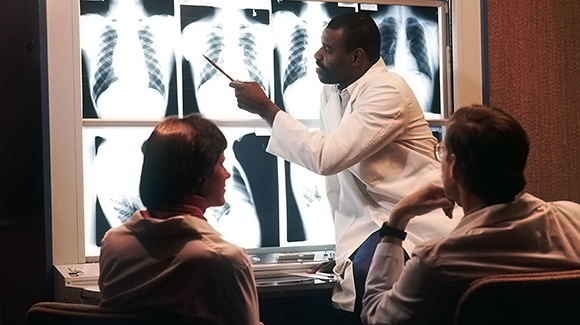
(Photo Credit: Bill Branson/NIST)
Historically, college enrollment in health care career programs has reflected a common issue confronting most of sciences and health fields: a lack of diversity. Adding to the difficulty, many prospective students from underrepresented populations would be the first in their family to attend post-secondary education and have few role models for health care careers.
“We have to go where our students are,” said Leila Stone, a counselor at Sacramento City College (SCC), regarding her outreach to high schools, community organizations and events. Stone promotes “allied health” careers, which are good-paying health care jobs outside of the nurse, doctor or dentist professions, and require significant training and education.
Most students Stone speaks to haven’t ever heard of physical therapy assistants, occupational therapist assistants or vocational nurses – career paths that start with a salary of $25 an hour and more.
“There are so many more career opportunities in health care than just doctors and nurses,” she said.
For a number of reasons, student enrollment in these fields lags in relationship to changing social demographics.
To address these issues, SCC developed an Allied Health Learning Community (AHLC), a two-and-half-year pathway of prerequisite and general education classes that prepare students to apply for an increasing number of allied health career programs as they proceed through the sequence and/or transfer to a four-year institution.
Before the AHLC was launched at SCC, there was a marked lack of diversity in the applicant pool. Though the students who applied for the allied health programs were being admitted, they did not reflect the economic and racial demographics of the local community. As a commuter school with a 65 percent poverty rate among students, there were plenty of challenges for students getting through the time-demanding prerequisites. Some science courses, for example, require 25 to 30 hours of study a week outside the structured class and labs.
“These cohort programs attract students who may not have the social capital to identify themselves as college students,” said Jim Collins, dean of the Science and Allied Health Division at SCC.
Just five years old, the program has impressive results. Fifty-one percent of AHLC students self-report as Hispanic/Latino – that’s 21 percent higher than the school-wide average. Every single student in the program has an individual education plan and completes the summer bridge program. The students enrolled in the program earn 45 percent more units than non-AHLC students and the average course success rate is eight percent higher than non-AHLC students with the same major.
“I decided to pursue the program because I liked the idea that I would be with the same group of people through the two years and they would provide an encouraging network,” said 22-year-old Rocio Hurtado, an AHLC graduate who completed two associate degrees and all of the transfer requirements for a California State University and is currently enrolled in SCC’s Registered Nursing Program.
“My favorite part was how involved the professors were to our success. I felt comfortable and encouraged to seek help with the difficult subjects,” she said.
Each year, staff members go into the community to introduce allied health professions and the AHLC program to those who might not otherwise pursue college. In the process, AHLC seeks to address the challenge of ethnic and racial disparity within the health care workforce, in particular the underrepresentation of Latino and African Americans.
Once the students start to see possibility in a career in allied health care, Stone and the AHLC staff work to help students and their families understand the differences between high school and college. After being admitted to the program, a student who used to babysit for their family every afternoon can’t continue to do so and he or she will need to study several hours a day. The family has to see the benefits of supporting their student’s education as a long-term investment.
Students who enroll in the AHLC start with a summer bridge program. The learning community they join provides support from teachers and peers and introduces them to allied health career role models that look like them and come from similar backgrounds. The program uses a contextualized and linked curriculum emphasizing authentic allied health practice and problem solving. Students also receive proactive, highly integrated case management to help them navigate all their real life issues such as jobs, family life, college support services, financial aid and time management.
“We’re trying to give our students a community with just-in-time service delivery,” explained Collins. “Students need someone from our system who cares about them,” he said.
Students also learn to watch out for one another. It’s not unusual for them to hold one another accountable for studying and attending classes.
To date, about 135 students have entered the AHLC. Some of the first students are completing their education and starting careers in a wide variety of allied health care professions.
“Once students have the commitment and see they can achieve, they can go to the highest levels,” said Stone.

